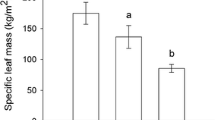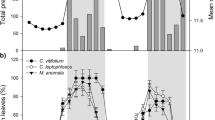Abstract
It is generally believed that tropical forests suffer more herbivory, as a proportion of leaf area, than do temperate forests. Reviews so far have compared studies performed by different authors using very different methodologies. Here we carried out studies on 125 samples at 86 localities in eastern North America and on 75 samples taken at five localities in Malaysia and Singapore, including both mature secondary and primary forest. Samples in North America were spread over 3 years. In tropical Asia, the samples were taken at four time slices at least 8 months apart, scattered over a 4-year period. Total herbivore damage during the lifetime of tree leaves was estimated from the percentage area damaged in recently fallen, undecayed leaves from the forest floor, using scanner-linked software. In terms of percentage damage per leaf, the results suggest that lowland tropical forest has significantly higher leaf herbivory (5.82%) than temperate forest (5.48%). This is in accord with the general expectation that aseasonal tropical forests should have more herbivory damage. However, when percentage damage ‘per unit time of growing season’ is calculated based on an estimate of leaf lifetime in the tropics, tropical lowland herbivory damage turns out to be a fraction (about one half) of that in the temperate zone. Thus, these results tend to put in question the widely held view that herbivore damage is markedly more intense in the tropics. Over total leaf lifetime, the intensity of damage in the tropical area is only slightly higher than temperate regions. In terms of intensity of herbivory on leaves per unit of time, the opposite seems to be the case. It is uncertain which index should be taken as more significant in interpreting the selection pressure for anti-herbivore defenses in the tropics.





Similar content being viewed by others
References
Adams JM, Zhang Y (2009) Is there more insect herbivory in warmer temperate climates?—A latitudinal comparison of insect folivory in eastern North America. J Ecol (in press)
Andrew NR, Hughes L (2005) Herbivore damage along a latitudinal gradient: relative impacts of different feeding guilds. Oikos 108:176–182. doi:10.1111/j.0030-1299.2005.13457.x
Coley P (1982) Rates of herbivory on different tropical trees. In: Leigh EG, Rand AS (eds) The ecology of a tropical forest. Smithsonian Press, Washington, DC
Coley PD, Aide TM (1991) Comparison of herbivory and plant defenses in temperate and tropical broad-leaved forests. In: Price PW, Lewinsohn TM, Fernandes GW, Benson WW (eds) Plant-animal interactions: evolutionary ecology in tropical and temperate regions. Wiley, NY, pp 25–49
Coley PD, Barone JA (1996) Herbivory and plant defenses in tropical forests. Annu Rev Ecol Syst 27:305–335. doi:10.1146/annurev.ecolsys.27.1.305
Cranshaw W (2004) Garden insects of North America. Princeton University Press, Princeton
Currano ED, Wilf P, Wing SL, Labandeira CC, Lovelock EC, Royer DL (2008) Sharply increased insect herbivory during the Paleocene–Eocene thermal maximum. Proc Natl Acad Sci USA 105:1960–1964. doi:10.1073/pnas.0708646105
Dobzhansky T (1950) Evolution in the tropics. Am Sci 38:209–221
Dyer LA, Singer MS, Lill JT, Stireman JO, Gentry GL, Marquis RJ, Ricklefs RE, Greeney HF, Wagner DL, Morais HC, Diniz IR, Kursar TA, Coley PD (2007) Host specificity of Lepidoptera in tropical and temperate forests. Nature 448:696–699. doi:10.1038/nature05884
Forkner RE, Marquis RJ, Lill JT (2004) Feeny revisited: condensed tannins as anti-herbivore defences in leaf-chewing herbivore communities of Quercus. Ecol Entomol 29:174–187. doi:10.1111/j.1365-2311.2004.0590.x
Grime P (2001) Plant strategies, vegetation processes and ecosystem properties. Wiley, Chichester
Halle F (2002) The global canopy handbook, techniques of access and study of the forest roof. Global Canopy Programme, Oxford University Press, Oxford
Janzen DH (1970) Herbivores and the number of tree species in tropical forests. Am Nat 104:501–528. doi:10.1086/282687
Kozlov MV (2008) Losses of birch foliage due to insect folivory along geographical gradients in Europe: a climate-driven pattern? Clim Change 87:1480–1573. doi:10.1007/s10584-007-9348-y
Lowman MD (1984) An assessment of techniques for measuring herbivory: is rainforest defoliation more intense than we thought? Biotropica 16:264–268. doi:10.2307/2387934
Lowman MD (1985) Temporal and spatial variability in insect grazing of the canopies of five Australian rainforest tree species. Aust J Ecol 10:7–24. doi:10.1111/j.1442-9993.1985.tb00859.x
MacArthur R (1969) Patterns of communities in the tropics. Biol J Linn Soc Lond 1:19–30. doi:10.1111/j.1095-8312.1969.tb01809.x
Morrow PA, Fox LR (1989) Estimates of pre-settlement insect damage in Australian and North American forests. Ecology 70:1055–1060. doi:10.2307/1941374
Novotny V, Basset Y, Miller SE, Weiblen GD, Bremer B, Cizek P, Drozd P (2002) Low host specificity of herbivorous insects in a tropical forest. Nature 416:841–844. doi:10.1038/416841a
Novotny V, Drozd P, Miller SE, Kulfan K, Janda M, Basset Y, Weiblen G (2006) Why are there so many species of herbivorous insects in tropical rainforests? Science 313:1115–1118
Pennings SC, Silliman BR (2005) Linking biogeography and community ecology: latitudinal variation in plant-herbivore interaction strength. Ecology 86:2310–2319. doi:10.1890/04-1022
Rijkers T (2000) Leaf function in tropical rain forest canopy trees: the effect of light on leaf morphology and physiology in different-sized trees. Thesis, Wageningen University, Wageningen
STATSGO 1994. U.S. General Soil Map. http://www.ncgc.nrcs.usda.gov/products/datasets/statsgo/description.html
Acknowledgments
We are especially grateful to Mei Ling Lee for her tireless assistance in this work, and Saleh Kamarudin of the FRIM Herbarium for the identification of our specimens. Hashim Md Noor of FRIM assisted us in our visits to field sites in an earlier pilot study that led on to the present work. We thank the two reviewers of this paper for their thorough and helpful suggestions. This work was partly supported by a Rutgers University Research Council Grant.
Author information
Authors and Affiliations
Corresponding author
Electronic supplementary material
Below is the link to the electronic supplementary material.
About this article
Cite this article
Adams, J.M., Zhang, Y., Basri, M. et al. Do tropical forest leaves suffer more insect herbivory? A comparison of tropical versus temperate herbivory, estimated from leaf litter. Ecol Res 24, 1381–1392 (2009). https://doi.org/10.1007/s11284-009-0623-4
Received:
Accepted:
Published:
Issue Date:
DOI: https://doi.org/10.1007/s11284-009-0623-4




